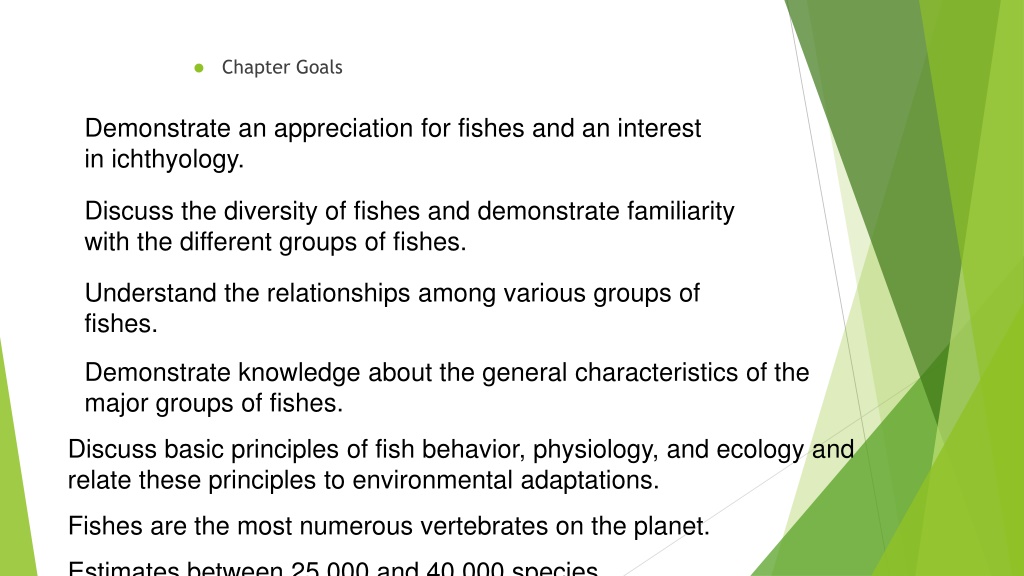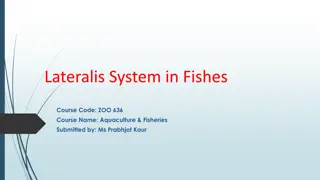Understanding the Fascinating World of Fishes: A Comprehensive Overview
Fishes, the most numerous vertebrates on Earth, exhibit incredible diversity across various groups such as Agnatha, Chondrichthyes, and Osteichthyes. From jawless Agnatha like lampreys to bony Osteichthyes including lobe-finned and ray-finned species, fishes display unique characteristics and adaptations for survival. Explore their behavior, physiology, ecology, and environmental adaptations to gain a deeper appreciation for these aquatic wonders.
Download Presentation

Please find below an Image/Link to download the presentation.
The content on the website is provided AS IS for your information and personal use only. It may not be sold, licensed, or shared on other websites without obtaining consent from the author. Download presentation by click this link. If you encounter any issues during the download, it is possible that the publisher has removed the file from their server.
E N D
Presentation Transcript
Chapter Goals Demonstrate an appreciation for fishes and an interest in ichthyology. Discuss the diversity of fishes and demonstrate familiarity with the different groups of fishes. Understand the relationships among various groups of fishes. Demonstrate knowledge about the general characteristics of the major groups of fishes. Discuss basic principles of fish behavior, physiology, and ecology and relate these principles to environmental adaptations. Fishes are the most numerous vertebrates on the planet. Estimates between 25,000 and 40,000 species
without jaws Lack paired appendages Most primitive of living fishes Superclass Agnatha Lampreys Round mouth with rasping tongue; feed on tissue and blood of prey Most, but not all, live as larvae in freshwater streams and migrate to sea as adults Hagfishes Mainly scavengers; lack rasping mouthparts; eyespots only Lack a larval stage and live entirely in salt water.
Class Chondrichthyes Includes sharks, rays, and their relatives Jaws and paired fins are well developed Skeleton made of cartilage Most are marine. There are about 1,000 living species. Fossil shark teeth are quite common in USA
Class Osteichthyes Bony Fishes Lobe-finned Fishes Lobe-finned Fishes are the ancestors of amphibians and all tetrapods Modern lobe-finned fishes include lungfishes and coelacanths All are freshwater. Lungfishes are found in Africa, South America, and Australia
Class Osteichthyes Ray-finned Fishes Fins are supported mainly by long, flexible rays. Modified for maneuvering, defense, and other functions. Include the fish most familiar to USA. Bass, trout, perch, catfish, tuna, herring, etc. Most numerous of all vertebrate classes. Number about 24,000 species Occur in all habitats where fishes occur. Range from approximately 3 miles above sea level to 7 miles beneath it.
Bony Fish Characteristics Endoskeleton made of bone Breathe by drawing water across gills Skin covered by scales Glands in the skin secrete mucus that reduces drag during swimming Swim bladder controls buoyancy of fish Possess a lateral line system
Parts of a Fish and Their Function Fins: Fins move, stabilize and sometimes protect the fish. A fish may have paired fins (pectoral and pelvic fins), and unpaired fins (anal, caudal, and dorsal fins). Some fish do not have all of these fins, and their placement shows great variability. The pelvic and pectoral fins are like the arms and legs of mammals. When they extend outward like oars (sunfish), the fish uses them for small maneuvers and in offsetting the propulsion effects of water going over the gills. When they extend outward like stubby wings, they may be used to prop the fish on the bottom or to hold on in strong currents The position of the pectoral and pelvic fins provides an important means of identifying major groups of fish.























